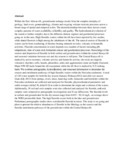| dc.identifier.citation | Olaka, L. A., Musolff, A., Mulch, A., Olago, D., & Odada, E. O. (2013, December). Lithological Influences on Occurrence of High-Fluoride Waters in The Central Kenya Rift. In AGU Fall Meeting Abstracts (Vol. 1, p. 1384). | en_US |
| dc.description.abstract | Within the East African rift, groundwater recharge results from the complex interplay of geology, land cover, geomorphology, climate and on going volcano-tectonic processes across a broad range of spatial and temporal scales. The interrelationships between these factors create complex patterns of water availability, reliability and quality. The hydrochemical evolution of the waters is further complex due to the different climatic regimes and geothermal processes going on in this area. High fluoridic waters within the rift have been reported by few studies, while dental fluorosis is high among the inhabitants of the rift. The natural sources of fluoride in waters can be from weathering of fluorine bearing minerals in rocks, volcanic or fumarolic activities. Fluoride concentration in water depends on a number of factors including pH, temperature, time of water-rock formation contact and geochemical processes. Knowledge of the sources and dispersion of fluoride in both surface and groundwaters within the central Kenya rift and seasonal variations between wet and dry seasons is still poor. The Central Kenya rift is marked by active tectonics, volcanic activity and fumarolic activity, the rocks are majorly volcanics: rhyolites, tuffs, basalts, phonolites, ashes and agglomerates some are highly fractured. Major NW-SE faults bound the rift escarpment while the rift floor is marked by N-S striking faults We combine petrographic, hydrochemistry and structural information to determine the sources and enrichment pathways of high fluoridic waters within the Naivasha catchment. A total of 120 water samples for both the dry season (January-February2012) and after wet season (June-July 2013) from springs, rivers, lakes, hand dug wells, fumaroles and boreholes within the Naivasha catchment are collected and analysed for fluoride, physicochemical parameters and stable isotopes (delta2 H, delta18 O) in order to determine the origin and evolution of the waters. Additionally, 30 soil and rock samples were also collected and analysed for fluoride, and rock samples were subjected to petrographic investigations and X-ray diffraction. The fluoride levels in surface and groundwater for the dry season range from 0.019 - 50.14 mg/L, on average above the WHO permissible limit. The high fluoride occurs both in the lake and groundwater. Preliminary petrographic studies show considerable fluoride in micas. The study is on-going and plans to present the relative abundances of fluoride in the lithology as the sources and the fluoride enrichment pathways of the groundwater within the Central Kenya rift. | en_US |

